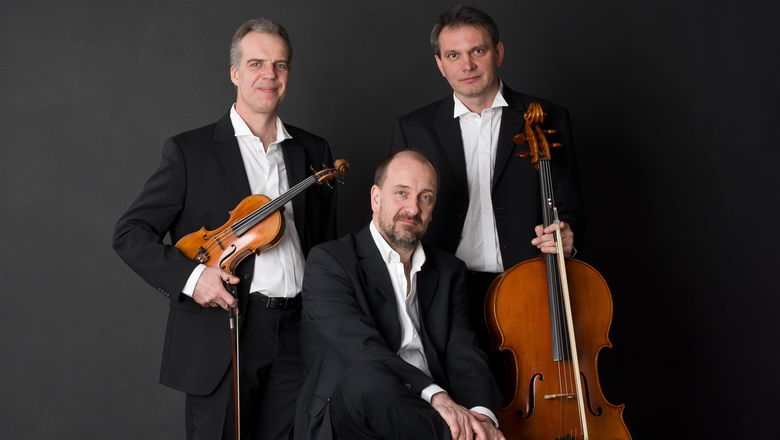1 / 6
Czech Chamber Music Society • Trio Martinů
The Trio Martinů is certainly one of the leading Czech chamber ensembles. Their return to the Czech Chamber Music Society features a programme of great works crowned by Smetana’s Trio in G minor, and of course they will not neglect their patron, Bohuslav Martinů.
Programme
Ludwig van Beethoven
Piano Trio in G major, Op. 121a, “Kakadu Variations” (17')
Bohuslav Martinů
Piano Trio No. 2 in D minor, H 327 (17')
— Intermission —
Bedřich Smetana
Piano Trio in G minor, Op. 15 (30')
Performers
Trio Martinů
Petr Jiříkovský piano
Pavel Šafařík violin
Jaroslav Matějka cello

Customer Service of Czech Philharmonic
Tel.: +420 227 059 227
E-mail: info@czechphilharmonic.cz
Customer service is available on weekdays from 9 a.m. to 6 p.m.
Performers
Trio Martinů
Compositions
Ludwig van Beethoven
Bohuslav Martinů
Piano Trio No. 2 in D minor, H 327
“I don’t know how it came about that I composed the Trio; it was sudden, as if I had written something entirely new by someone else’s hand.” That is how Bohuslav Martinů described the creation of his First Piano Trio in 1930 in Paris. He surprised himself with its “entirely new” musical language. In the work, he was moving experimentally in a world of composition towards which he worked gradually over the course of several years. Subtitled “Five Short Pieces”, the work differs at first glance from the usual three-movement layout that is typical of the piano trio genre. He wrote his next work for violin, cello and piano in 1939, also in Paris. It also has five movements, and in this case Martinů did not even call it a piano trio, instead merely giving it the one-word title Bergerettes. It was not until 1950 that he wrote his next chamber work for violin, cello, and piano. By then, he had been living in the USA for ten years, having moved there from France because of the Nazi occupation, and post-war political developments in Czechoslovakia had prevented him from returning to his homeland. This time, he gave his new work the standard title for the genre and even labelled it in the “old-fashioned” manner with its key as his Piano Trio No. 2 in D minor. Had he ceased with experimentation and composing in a modern idiom? Not at all. Martinů was able to pour his own personality and unrestrained expression into the work even within the bounds of entirely traditional forms, from which many composers were distancing themselves at the time. Martinů wrote the trio in February 1950 in New York on commission for the Massachusetts Institute of Technology (MIT) in Cambridge on the occasion of the opening of the Hayden Library, named for Charles Hayden, a prominent American banker and philanthropist. To this day at the prestigious Hayden Library, a sketch for the trio is proudly preserved. The library can boast that the work’s world premiere was given on the premises on 19 May 1950 by two MIT professors (Klaus Liepmann, violin, Gregory Tucker, piano) and another professor from Bennington College (George Finckel, cello). After the premiere, tea was served in Hayden’s garden. While the Hayden Library is an outstanding example of the Art Moderne architectural style after the Second World War, the musical work heard at its grand opening is just as supremely modern. It organically combines American energy with Czech musical traditions that had been the composer’s departure point, and towards which he was increasingly returning. Bohuslav Martinů did not live to see the trio issued in print in 1961 by the Parisian publisher Max Eschig.
Bedřich Smetana
Piano Trio in G minor, Op. 15
We now rate Smetana’s only piano trio as one of the finest chamber works written by Europe’s most important composers at the time. It is a pity that this modern composition remained hidden in manuscript form for so long. Smetana’s immediate stimulus for composing his Piano Trio in G minor was the death of his beloved first-born daughter, whom he called Friederika, Bedřiška, or Fricínka in his German or Czech writings. He mentioned her repeatedly in connection with the trio: “a remembrance of my first child Bedřiška, who carried us away with her extraordinary musical talent, but was soon torn from us by inexorable death at four and a half years of age.” She died of scarlet fever on 6 September 1855. Smetana finished the composition on 22 November 1855, and it was already heard in public for the first time on 3 December of that year in Prague’s Konvikt Hall. Joining Smetana at the piano were the violinist Otto Friedrich Königslöw and the cellist Johann August Julius Goltermann. Into his trio, Smetana poured all of the artistry he had so far attained. This was also appreciated by Franz Liszt during his visit to Prague in September 1856, when the same performers played the trio at Smetana’s home, about which the composer later recalled in a letter: “A year later we played it at my home for Liszt, who embraced me and congratulated my wife because of the work.” A year and a half after the premiere, in May 1857, Smetana went back and revised some passages in the trio. By then, he was working in Gothenburg, Sweden, and at the time he wrote in his diary: “Today I reworked the whole first movement of the trio, and I am satisfied with it as it now stands.” The revised version, which is basically the form in which the work is now known, was performed on 11 February 1858 in Gothenburg, again with the composer at the piano, and with the violin and cello parts played by Josef Čapek and August Meissner. Despite Smetana’s efforts, for a long time he could not find anyone to publish the work. He did not succeed until a quarter century later. Thanks to the selfless efforts of Jan Ludevít Procházka to promote Smetana’s music, the Hamburg publisher Hugo Pohle printed the trio in 1880 with the opus number 15.